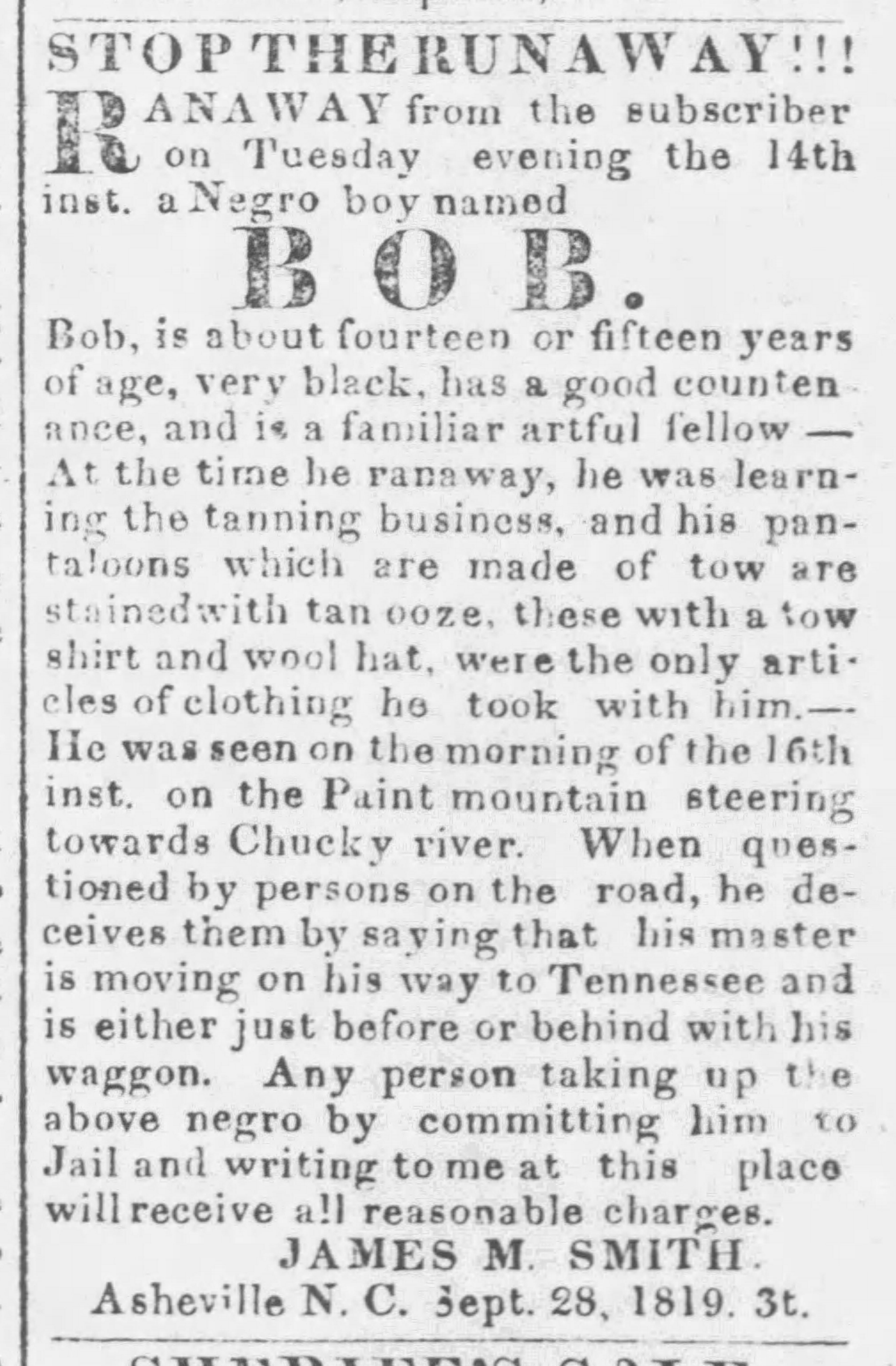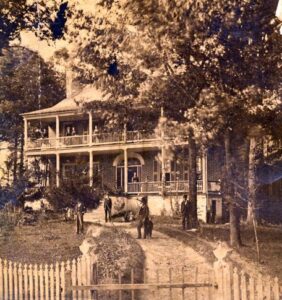
A trek of self-liberation from Asheville to Tennessee
In trying to determine whether Bob found freedom in 1819, the written historic record can provide some clues. Unfortunately, more often than not, this documentation was written by enslavers as enslaved individuals were not legally allowed to learn to read or write. So even those who were literate had to hide their abilities or be subject to severe lashings. The above story of Bob’s escape is taken entirely from the advertisement written by James Smith as he attempted to apprehend Bob.

On Tuesday evening, Sept. 14, 1819, Bob, a 14-year-old “familiar artful fellow … (with) a good countenance” liberated himself from his captor, James Smith, in Asheville. He traveled north along the Buncombe Turnpike toward Paint Mountain and into Tennessee.
Bob took little on his journey; he wore the only clothing he had, a wool hat and a shirt and pair of pants made of rough spun flax, all stained with ooze from the leather tanning trade he had been forced to learn at James Smith’s tannery in Asheville.
But someone had sighted the young man near the Tennessee border on Sept. 16 and reported back to James. Despite the threat of being caught and severely punished, Bob continued his resistance. By Sept. 28, when James ran an advertisement in the Knoxville Register offering a reward for anyone who jailed Bob, the young man had not been found. James ran the advertisement through Oct. 12.
It is a common misconception that slavery did not exist in the mountains of Western North Carolina. In fact, prior to the victory of the United States Army in 1865, most wealthy and middle class landowners in the Asheville area held people captive, and a few enslaved more than 100 individuals to work on their farms and in their households and businesses.
In trying to determine whether Bob found freedom in 1819, the written historic record can provide some clues. Unfortunately, more often than not, this documentation was written by enslavers as enslaved individuals were not legally allowed to learn to read or write. So even those who were literate had to hide their abilities or be subject to severe lashings. The above story of Bob’s escape is taken entirely from the advertisement written by James Smith as he attempted to apprehend Bob.
According to the U.S. Census, by 1820 James enslaved nine people, including one unnamed (in the written record) male between the ages of 14 and 25, the age Bob would have been at the time. Then, in 1821, less than two years after 14-year-old Bob made his escape to Tennessee, James purchased a “boy” named Bob from the estate of Michael Israel for $760 — the equivalent of about $19,000 in 2022 dollars. By 1840, James held 70 men, women and children captive. He also served as the town jailer, imprisoning, punishing and re-enslaving people attempting to escape.
It was around this time that James, now at the height of his power and influence on Asheville society, began utilizing the wealth he had accumulated through the forced labor of others to break ground on his land holdings near the confluence of the Swannanoa and French Broad rivers. James then had these same enslaved individuals construct a three-story brick mansion that would serve as a retreat from his family’s primary residence in downtown Asheville.
But it was not until James wrote the first version of his will in 1850 that a man enslaved by James named Bob reappeared in the written record. Here, James willed Bob, a tanner, and Bob’s wife, Lidia, and their children to his wife, Polly. Whether Bob the tanner is the same Bob who sought his freedom in 1819 is currently unknown; however, census data indicates that their birth years were similar.
When James died in 1856, Polly had already died, so Bob, Lidia and their children were most likely forced into the household of one of James’ children.
James also accounted for numerous other enslaved individuals in his will. One woman, Tilda, died after James wrote his initial will, which he acknowledged in an 1853 amendment. Tilda’s widower, Joe, a waggoner, and their children, Alfred, Joe Jr., Mary, Jane and Vina, were then inherited along with the Smith’s brick mansion by James’ son, John.
When John then died at age 32 without a will, Tilda’s family went up for auction on the steps of the Buncombe County Courthouse in Asheville alongside the mansion. One of James’ daughters purchased the mansion. Four different enslavers purchased members of Tilda’s family. Only 11-year-old Mary and 9-year-old Vina were sold together. At this time, the fates of Tilda’s family after 1858 are unknown.
However, it was also around 1858 that a woman in Chunns Cove, just east of downtown Asheville, purchased her freedom with the help of her husband. The newly-free couple, Eliza and John Henry, settled on land in the same cove and opened their home and provided provisions to people making their way north as they attempted to escape enslavement. According to their grandson, Johnny Baxter, the Henrys built a secret sliding wall in their house that concealed a safe resting place for freedom seekers.
“This story (my grandmother) told about two slaves that had broken away from their owners and had come to their station for help,” Johnny Baxter explained. “These two fellows came there in the middle of the night. … Shortly after, these men came there looking for them. Everything was orderly because (my grandparents) just slid this door right back and let (the freedom seekers) go in there. … (The slave patrolers) wanted to know if these runaway slaves had come. (My grandparents) said, ‘No, we haven’t seen any strangers or anything of that sort. … Go ahead and search. You look around and see if they’re here.’ They knew they wouldn’t find them, but that was a good way to kind of convince them that they hadn’t seen anybody.”
Little else is currently known about this Asheville-area stop on the network known as the Underground Railroad, which helped enslaved people find freedom, due to the secretive nature of the enterprise. As Baxter remembered, “I doubt seriously if anybody in the vicinity knew about (my grandparent’s safe house) because those places were supposed to be kept secret, those underground stations.”
In 1866, a year after Asheville’s enslaved population was emancipated, Bob and Lidia filed a cohabitation record to officially acknowledge their nearly 50-year marriage in the eyes of the government. Bob listed his name on this document as Robert Smith. By 1870, the couple, now in their late 60s, had taken a new last name, Haynes. They and their children helped to create a thriving post-Civil War economy in Asheville — despite continuing to face systemic racism — by choosing to work as tanners, farmers, cooks, shoemakers, laundresses, doctors, nurses, teachers and business owners.
The Smith mansion, now known as the Smith-McDowell House, has been on the National Register of Historic Places since 1974. It still stands and is now home to the Western North Carolina Historical Association. When WNCHA took ownership of the house in 2020, the association embarked on a project to research and record the stories of the more than 100 individuals who were held captive by the Smith and McDowell families. It is a work in progress and can be found at www.wnchistory.org/deep-dive. The association is seeking further information, including photographs, letters, and oral traditions — like Johnny Baxter’s memories of the stories told to him by his grandmother, Eliza Henry — to help fill in large gaps in the historical written record.
Anne Chesky Smith is the executive director of the Asheville Museum of History. This article was written with research assistance from Atalaya Dorfield with the Great Smokies African American Experience Project. This article was first published in the Asheville Citizen-Times on March 28, 2022.
